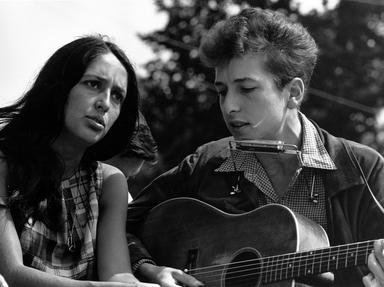Quiz Answer Key and Fun Facts
1. On which Bob Dylan album did "A Hard Rain's a-Gonna Fall" first appear?
2. In "Chronicles Volume One," Bob Dylan said this song was inspired by the feeling he got when reading what in the New York Public Library?
3. What October 1962 event is often mistakenly cited as inspiration for "A Hard Rain's a-Gonna Fall"?
4. Bob Dylan modeled this song after the Anglo-Scottish border ballad "Lord Randal." In that ballad, when Lord Randal returns home, his mother asks him a series of questions. He answers those questions, only to eventually reveal what?
5. Dylan has confirmed that the "hard rain" of this song refers to acid rain from nuclear fallout.
6. What is one of the primary literary devices used in this song, as evidenced by such phrases as "twelve misty mountains," "seven sad forests," "a dozen dead oceans," and the "depths of the deepest black forest"?
7. "A Hard Rain's a-Gonna Fall" is written entirely in rhymed couplets.
8. Which of the following questions is NOT posed in this song?
9. The blue-eyed son has been "ten thousand miles in the mouth of a" what?
10. The blue-eyed son met one man who was "wounded in love" and another who was "wounded with" what?
11. Which of the following did the blue-eyed son NOT meet?
12. What did the blue-eyed son see that had "wild wolves all around it"?
13. What did the blue-eyed son see "in the hands of young children"?
14. Which of the following did the blue-eyed son NOT hear?
15. "Heard the song of a _____ who died in the gutter." Who died in the gutter?
16. "Where the pellets of _____ are flooding their waters." What words is missing from this blank?
17. Whose "face is always well hidden"?
18. "Black is the color," but what "is the number"?
19. What British singer, who rose to fame as part of the glam art rock band Roxy Music, recorded an unusual peppy, pop version of "A Hard Rain's a-Gonna Fall" on his 1973 debut solo album "These Foolish Things?"
20. What American author, poet, singer, songwriter, and punk rocker performed a version of this song at the Nobel Prize Award Ceremony when Bob Dylan received the Nobel Prize in Literature?
Source: Author
skylarb
This quiz was reviewed by FunTrivia editor
1nn1 before going online.
Any errors found in FunTrivia content are routinely corrected through our feedback system.
